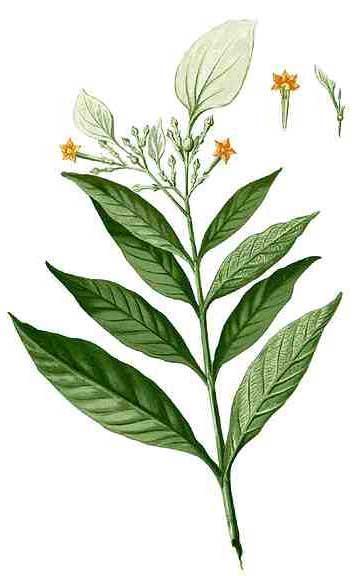 Botanical snippet Botanical snippet
- A plant species in the Rubiaceae family, commonly grown as an ornamental.
- Known varieties are: Donna Luz (pink), Alicia Luz (dark pink), Queen Sirikit (light pink), Donna Aurora (white) and Donna Evangellina (dark red).
(15)
Botany
Kahoi-dalaga is a shrub or small tree
3 to 5 meters high, more or less hairy or nearly smooth. Leaves are
opposite, dark green and glossy, oblong-ovate to oblong-lanceolate, 6 to 14 centimeters long, pointed in
both ends, and furnished with stipules about 4 millimeters long. Flowers are borne in small numbers in terminal, hairy cymes. Calyx is about 7 millimeters long, with four of the teeth as long as the tube, one very much enlarged into a white, leaflike, long petiole, elliptic-ovate appendage, the blade 4 to 8 centimeters long. Corolla is yellow, hairy, about 2 centimeters long, and enlarged upward. Fruit is about 1.5 centimeters long.
Distribution
- In thickets and secondary
forests at low and medium altitudes, in almost all islands and provinces.
- Ornamental cultivation.
Constituents
- Flowers yielded saponins, flavonoids, tannins, carbohydrates and resins.
Parts used
Roots, leaves, sepals.
Uses
Folkloric
- Plant is used for
dysentery and snake bites.
• Decoction of roots and leaves used for affections of the chest
and lung.
• Root and the while, full-grown sepals are used in jaundice.
• Bark used for stomach ache.
• Externally, decoction of leaves used as emollient.
• For influenza, the tambalan healers of Samar use the scrapping of the bark of M. philippica and C.
dichotoma. Mixed and pounded, the expressed juice strained and mixed with lemon extract; taken three times daily.
Studies
• Antibacterial / Leaves: A methanol extract of leaves, flowers, stems and barks, hexane and ethyl acetate extracts of stems/bark showed mild inhibition of Bacillus subtilis growth. (2)
• Anticonvulsant / Leaves and Sepals: Study evaluated the anticonvulsant activity of hydroalcoholic extracts of leaves and sepals and its fractions against PTZ, MES, STR, Picrotoxin induced convulsions at different dose levels. Results showed dose-dependent effects which may have potential in the control of grandmal and petit mal epilepsy. (3)
• Antitumor: Study evaluated the antitumor and antioxidant activity of Mussaenda philippica against MCF-7 and Caco2 cell lines induced breast and colon cancer in mice. (4)
• Diuretic / Flowers: Study evaluated the diuretic activity of flowers of Mussaenda philippica var. Donya Luz. Results showed the crude extract of possess potential diuretic activity which could be further explored in the treatment of hypertension. (5)
• Analgesic: In a screening study of ten medicinal plants of Bangladesh for analgesic activity on Swiss albino mice, M. philippica effectively inhibited acetic acid-induced writhing. The reference drug was diclofenac. (6)
• Antioxidant / Antibacterial: Study evaluated the phytochemical, antioxidant and bacterial profile of flowers of selected ornamental plants from Nueva Viscaya, Philippines. Results showed M. philippica was bioactive against Staphylococcus aureus and E. coli. (7)
• Antitumor / Antioxidant / Sepals: Study evaluated the antitumor and antioxidant activity of an EA extract of Mussaenda philippica sepals against Caco-2 cell line in male mice for colon cancer and MCF-7 cell line in female mice for breast cancer. Results showed antitumor and antioxidant effects by modulating lipid peroxidation and augmenting antioxidant defense system in Caco-2 and MCF-7 bearing mice. (10)
• Hepatoprotective / Anti-Tubercular Drug Toxicity / Stems: Study of a methanolic extract of M. philippica against isoniazid and rifampicin induced hepatotoxicity in an experimental rat model showed significant hepatoprotective activity. (11)
• Antiulcer / Anti-Secretory / Cytoprotective / Leaves: Study evaluated the antiulcer property of M. philippica leaves using pylorus ligated, ethanol induced, and NaOH induced ulcer models in rats. Results showed substantial reduction in ulcer index, decrease in gastric volume, increase in pH in the pylorus ligation model, probably through alteration in the mucosal barrier. In the ethanol induced model, there was significant antiulcer effect, which may be due to leukotriene antagonistic effect or inhibition of the 5-lipoxygenase pathway. In the NaOH model, the antiulcer effect was attributed to effect on pH and ulcer index. (12)
• Antimicrobial / Leaves: Study evaluated the antibacterial and antifungal activity of three solvent extracts of A. pavonina and Mussaenda philippica on microbes isolated from dairy cattle. The extracts exhibited antibacterial activity against Salmonella enteritidis, Klebsiella pneumoniae, Bacillus subtilis, Staphylococcus aureus, Escherichia coli and Pseudomonas aeruginosa. (13)
Availability
Wild-crafted
|



![]()

